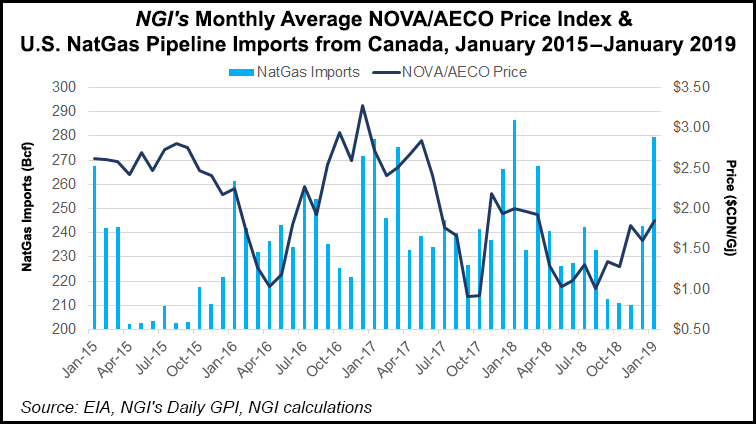NGI The Weekly Gas Market Report | Markets | NGI All News Access
Canadian Natural Gas Exports Declined in 2018
The volume and value of Canadian natural gas exports fell last year, according to trade records compiled by the National Energy Board (NEB).

Pipeline deliveries to the United States dropped by 5% to 7.8 Bcf/d in 2018 from 8.2 Bcf/d in 2017. Meanwhile, Canadian gas export revenue shrank by 7% to C$9.6 billion ($7.2 billion) over the same time.
Canadian gas imports from the United States also receded year/year, dropping by 8% to 2.2 Bcf/d in 2018. Similarly, the value of Canadian imports from the Lower 48 declined by 3% to C$3.5 billion ($2.6 billion).
The 2018 Canadian pipeline exports were also down from 8.1 Bcf/d in 2016, but remained stronger than their volumes of 7.3 Bcf/d in 2014 and 7.4 Bcf/d in 2015.
The NEB’s five-year record registers big gas price and revenue losses by both sides in the cross-border trade between Canada and the United States.
The 2018 Canadian gas export revenue of C$9.6 billion ($7.2 billion) was down by 39% from C$15.7 billion ($11.8 billion) in 2014. Over the same period, the value of Canadian gas imports from the United States dropped almost as fast, going down by 31% to C$3.5 billion ($2.6 billion) in 2018.
The lackluster trade volume and revenue performances inspire the same message in the Canadian oil sector; overseas markets are increasingly crowded with rival supplies of both commodities.
Only liquefied natural gas exports would be “capable of altering the Canadian gas outlook for the better,” said Sproule Associates’ Chris Mylde, vice president, who spoke at a recent industry conference held by the University of Calgary’s Haskayne School of Business.
“Canada has potential to be a major player,” said Mylde, whose roles include university instructor and energy price forecaster for the prominent Calgary engineering and earth sciences consulting firm.
Big unconventional gas deposits in Alberta and British Columbia (BC), competitive operating expenses and shorter shipping times to Asia than the U.S. industry at least partly offset higher project construction costs, he said, noting that “Canadian projects stack up pretty well.”
He voiced hope that the first northern Pacific coast export outlet, the LNG Canada project now beginning construction in BC, would aid growth in the Canadian gas industry.
© 2024 Natural Gas Intelligence. All rights reserved.
ISSN © 1532-1231 | ISSN © 2577-9877 | ISSN © 1532-1266 |
